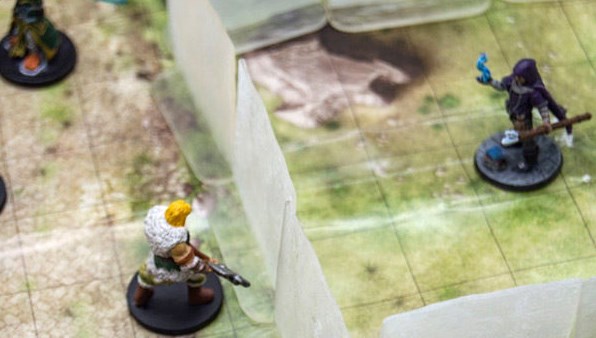Ray of Sickness is the spell we all wish we had as children. Not only can it help you fake sick long enough to get out of going to school, but you also wouldn’t need to mix up your own fake vomit (did anyone actually do that?). Now, you can bring it into your Dungeon and Dragons game and help get your characters out of going to school.
In all seriousness, Ray of Sickness is one of the best first-level Necromancy spells that one can take, though it is limited in its capabilities, as most first-level spells are. However, as with everything in Dungeons and Dragons, all it takes is a spark of creativity to make it into something entirely new.
Welcome to a Ray of Sickness 5e Guide.
Bottom Line
Ray of Sickness is a first-level Necromancy spell with a range of sixty feet. It requires Verbal and Somatic components, requiring a ranged attack roll and dealing 2d8 poison damage.
If you hit, your target must make a Constitution saving throw or be poisoned until the end of your next turn. This spell maintains some uses outside combat, mainly for creating a temporary sickness.
This spell is available to Wizards, Sorcerers, and Clerics in the Death Domain.
The Basics
Ray of Sickness is a 1st-level Necromancy spell. It takes a single action to cast, boasting a range of sixty feet. The only components required to cast Ray of Sickness are Verbal and Somatic.
How it Works

When casting this spell, you release a ray of sickening green energy that lashes out toward your target. You must make a ranged spell attack against that target. On a hit, your target will take 2d8 poison damage and needs to make a Constitution saving throw. On a failed save, the target will remain poisoned until the end of your next turn.
When you cast this spell at a second-level spell slot or higher, the damage will increase by 1d8 for each slot level above first. 2d8 poison damage is quite a bit for a first-level spell and ensures that you can do some serious damage from the start.
What does the Poison Effect Do?
As an added benefit of this first-level spell, your target has the chance to become poisoned. The poisoned effect gives a creature disadvantage on all Attack rolls and Ability Checks until the effect wears off or is overcome. The DC, or Difficulty Challenge, to overcome for your target is based on your Spell Save DC. For Ray of Sickness, this lasts until your next turn.
What is the School of Necromancy?
The School of Necromancy is one of the many types of magic. In this School, spells explore the forces of life, death, and undeath. Many of the later-game spells in this School of Magic are often considered taboo and are heavily associated with negativity and evil.
Since Ray of Sickness is a spell that temporarily sickens the target, taking health in the process, it easily falls into the category of Necromancy. If you are staunchly good-aligned and refuse to use Necromancy spells, I wouldn’t worry too much about this one staining your reputation.
You’ll be fine with spells like “Finger of Death” on the table. Other than that, if you refuse to use spells from the School of Necromancy, I’d start figuring out how you’re going to revive party members, considering that every resurrection spell falls under the domain of Necromancy.
Maximizing The Spell

Although this is a first-level spell, it retains its utility outside of the first level. Not only does the damage increase if you cast Ray of Sickness at a higher spell level, but it becomes harder to beat the Constitution Saving Throw as your Spell Save DC goes up.
If you want to make this spell extra useful, along with many of your other ranged attack spells, consider taking the Feat Spell Sniper. This doubles the range of any spell requiring a ranged attack roll and ignores all partial cover. Paired with Spell Sniper, your Ray of Sickness can have a 120-foot range.
Better in the Early Game or in the Late Game
Although this spell seems really good for a first-level spell, there comes a time when you need to ask if it’s worth it to keep using it. Indeed, when you’ve got higher-level spells that undoubtedly have more impact or inflict more damage, it seems unwise to keep expending your spell slots. So, let’s break it down and look at some higher-level alternatives.
The Player
Ray of Sickness is better in the early game. It deals a decent amount of damage, but as you progress throughout your campaigns, you will undoubtedly come across strong spells or, at the very least, can provide a longer-lasting effect.
If your goal is to give your target a disadvantage on their rolls, then something like Blindness/Deafness may prove more effective and harder to beat. However, the problem with Blindness/Deafness is that it doesn’t deal damage like Ray of Sickness can.
However, Ray of Sickness may end up sufficing until you are able to gain a fifth-level spell slot. At this point, you should have access to the spell Contagion. Contagion provides an even more dangerous effect than Ray of Sickness does, though it requires that you make a melee spell attack and are able to touch your target.
They must make a Constitution saving throw still, however. If they fail three Constitution saving throws, the disease you’ve thrust upon them takes hold, and they can no longer make Constitution saving throws against the spell until it ends after seven days.
The Dungeon Master

Ray of Sickness is worth it to use in the late game. Unlike the Players, where your goal is to beat the enemy as quickly as possible, Ray of Sickness on your end can be a temporary nuisance to your players.
It depends on the type of campaign you’re running and the boss your players are facing, but if they aren’t a serious threat and instead are somewhat of a nuisance and a persistent one at that, Ray of Sickness is one of the perfect spells.
It deals short-term poison damage, and what damage the spell does can end up proving to be a minor threat. At the base level, you can roll 16 damage, though that’s probably not going to happen.
You likely won’t want your serious Big Bad to use Ray of Sickness as a first-level spell and would probably want to push them to use something like Ray of Enfeeblement or Contagion instead. These are higher-level spells that carry a more serious threat than Ray of Sickness does while still providing a similar, if more complex, effect.
Who Can Use It
This spell is only available to Sorcerers, Wizards, and Clerics in the Death Domain. Though if you were to take a feat like Magic Initiate, you would be able to get around the class barrier. Considering this spell is first-level, it should be available to take right out of the gate.
Ray of Sickness is one of the better spells to take right off of the bat as well, especially if you’re a Sorcerer or Wizard and don’t have access to every spell available to you. Ray of Sickness can deal up to 16 damage right away and keep you and your party members from being hit due to the poisoned effect.
For Clerics, this added benefit is even better because it can help you conserve your spell slots so you can deal damage, rather than needing to use them for healing over and over again.
Getting Creative

It is, admittedly, difficult to get creative with Attack spells. You can add extra flair when describing the spell or change the look of it, so it matches your character better, but other than that, there isn’t much you could do with it… or so you think.
Have you ever wanted to realistically fake sick to get out of a situation? I distinctly recall faking sick when I was a kid and then getting called out because it wasn’t realistic enough.
Well, Ray of Sickness can provide that out for you and make it look super realistic. When making attacks, you can purposefully choose to do the least amount of damage possible, which in this case would be two.
You can also purposefully choose to fail your Saving Throws to let a specific effect take hold of you. In the case of Ray of Sickness, that can give you a temporary poisoned effect or a “sickness.” This not only could help you get out of some situations, but it might help you to get in.
Let’s say that your characters are attempting to break into the sick ward of a hospital, but none of you have a good enough deception check. Well, all you need is a willing participant and a spellcaster who doesn’t mind tossing a few first-level spell slots out the window. With a hand on their back, they can cast Ray of Sickness when needed (hopefully discreetly!) and get your willing victim into the sick ward!
After six seconds, the effect will wear off (hence the constant casting), but hopefully, only one will be good enough to convince. Your willing participant just needs to keep the act going for long enough that it doesn’t immediately become suspicious.
FAQs
Question: What are Somatic Components?
Answer: In Dungeons and Dragons 5e, most spells have one or two components, if not three. The three components spells you need are Verbal, Somatic, and Material. While Verbal and Material are fairly obvious, Somatic may not be. If a spell lists that it requires Somatic components, it means that the spellcaster has to make some kind of a gesture or move their body in a specific way for the spell to activate.
I like to imagine that this is mostly dictated by specific hand movements, but it could very well just mean your magic user has to literally dance on the battlefield to activate their spells. It is something that adds “flavor” to your spellcasting. However, there is a legitimate mechanic involved; if you are restrained and unable to move, you cannot cast spells with Somatic components – so make sure that you pay attention.
Question: What is a Feat?
Answer: A Feat is an option that you can take upon reaching specific levels. You can take a Feat instead of an Ability Score raise at levels 4, 8, 12, 16, and 19. Feats give you perks in gameplay usually and can help you in battle or in roleplay situations. Some Feats may even raise your Ability Scores, which is a two-for-one type of deal. The best Feat heavily depends on the type of character that you’re playing, but I recommend the Lucky Feat if you don’t know where to start. It allows for you to re-roll a d20 up to three times or force someone else to re-roll their attack roll against you.
Question: How do I calculate my Spell Save DC?
Answer: It’s a fairly simple equation, thankfully. Make sure you write it down somewhere (your character sheet is a good idea). It’s 8 + your Spell Ability Modifier + your Proficiency Bonus.
Ray of Sickness 5e Guide: Final Thoughts
Although traditionally thought of as an Attack spell, Ray of Sickness has other uses. As a low-level spell, it offers a benefit that higher leveled Attack spell might not – usability. Ray of Sickness can technically be used outside of combat to create a temporary and believable sickness.
Although this may not be one of the best ideas that a party could pull, it certainly is a creative one, giving the spell a unique twist. One of the hardest parts about playing a spell caster in Dungeons and Dragons 5e is deciding what spells to use for the day.
Being able to take creative twists with your spells and use them outside of highly specific situations can be vital. Ray of Sickness is a straightforward spell, but with a little bit of creative thinking, it can be worthwhile in both the early game and in the long run.
- Hand Crossbow 5e Guide – For Everyone but Druids and Wizards - December 16, 2022
- Compelled Duel 5e Guide - November 14, 2022
- Heavily Obscured 5e Guide – The Ins And Outs Of The Dark - October 31, 2022

